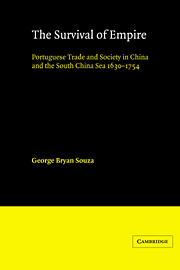Book contents
- Frontmatter
- Contents
- List of figures, maps and tables
- Glossary
- Notes on spelling and currency, weights and measures
- Preface
- 1 Maritime trade in Asia
- 2 Imperial foundations: the Estado da India and Macao
- 3 Population, personalities, and communal power
- 4 Country traders and Crown monopoly
- 5 Merchants and markets
- 6 Country traders and the search for markets
- 7 Imperial relations: Macao and the Estado da India
- 8 Imperial survival: Sino-Portuguese relations from Ming to Ch'ing
- 9 Macao, Companies and country traders: the other Europeans in China
- 10 Conclusion
- List of abbreviations and notes
- Primary Sources
- Bibliography
- Index
2 - Imperial foundations: the Estado da India and Macao
Published online by Cambridge University Press: 24 October 2009
- Frontmatter
- Contents
- List of figures, maps and tables
- Glossary
- Notes on spelling and currency, weights and measures
- Preface
- 1 Maritime trade in Asia
- 2 Imperial foundations: the Estado da India and Macao
- 3 Population, personalities, and communal power
- 4 Country traders and Crown monopoly
- 5 Merchants and markets
- 6 Country traders and the search for markets
- 7 Imperial relations: Macao and the Estado da India
- 8 Imperial survival: Sino-Portuguese relations from Ming to Ch'ing
- 9 Macao, Companies and country traders: the other Europeans in China
- 10 Conclusion
- List of abbreviations and notes
- Primary Sources
- Bibliography
- Index
Summary
After their arrival in the Indian Ocean in 1498 and a short period of operation in southern India, the Portuguese established the administrative and political centre of their Asian empire at Goa. The Estado da India, the State of India, the name given by the Portuguese Crown to this imperial enterprise, was not a unitary state but a collection of forts, fleets, and communities that stretched from east Africa to Japan.
The Crown's representatives were preoccupied with the construction of an economic system of empire and their personal enrichment. Their basic objective was to dominate Asian maritime trade in spices, pepper in particular, and to force existing maritime trading activities to pay for permission to trade in the Indian Ocean; their energy, exchequer and manpower were committed ostensibly to this enterprise. The economic benefits to the Crown in establishing the Estado da India were obvious and the benefit to its supporters was to be ensured by patronage.
There was, also, a strong religious objective in the establishment of the Estado da India. Portugal, as a major Catholic power and with the major role of the Catholic Church in that society, possessed a real interest in the propagation of the Christian faith and a crusading zeal against Islam. With the Counter-Reformation, the Crown re-doubled its involvement and support for Catholic missionary activity in Asia.
Despite startlingly successful initial naval and military activities, the Crown's principal economic objective of establishing a Portuguese monopoly over the supply of spices to Europe was impossible to fulfil.
- Type
- Chapter
- Information
- The Survival of EmpirePortuguese Trade and Society in China and the South China Sea 1630–1754, pp. 12 - 29Publisher: Cambridge University PressPrint publication year: 1986

